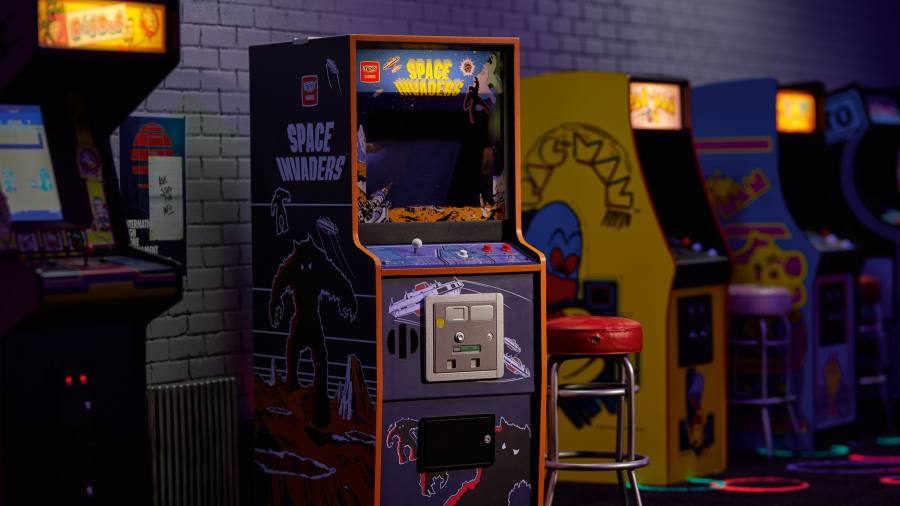Receive free Gadgets updates
We’ll send you a myFT Daily Digest email rounding up the latest Gadgets news every morning.
Real Wild One
The Little Car Company has made its reputation by producing beautifully detailed, scaled-down versions of classic cars: battery-powered Aston Martins, Bugattis and Ferraris that can be driven by kids (or small adults!) on private land. But for its latest project this idea was flipped on its head: what if you took a popular remote-control car from the ’80s and scaled it up to produce a road-legal vehicle?
The RC it chose was the Tamiya Wild One 58050, originally launched in 1985 and much loved for its indestructibility (to a point) and ability to deal with difficult terrain; a popular TV advert of the day featured the car bombing effortlessly around sand dunes. It was billed on the cardboard box as a “1/10th scale, off-road high-performance racer”, but it wasn’t actually modelled on a car 10 times the size. Such a car never existed. So, having trailed the idea and received overwhelmingly positive feedback, The Little Car Company had the task of scaling it up. This posed some unique challenges, because if you were going to design a car from scratch, you certainly wouldn’t start here.
The original car featured a driver sitting at the wheel, but when scaled up it became clear there was insufficient room for their legs, or indeed their head. (Not ideal.) The original had no windscreen, which clearly wouldn’t meet safety standards, and nor would the bonnet spotlights masquerading as headlamps. But with the involvement of the community who placed pre-orders, the company’s design team succeeded in constructing a road-legal car, 3.6m long, which to all intents and purposes is a Wild One replica, officially licensed by Tamiya.
A few welcome differences: there are two bucket seats (because of course you’d want to take a passenger); it’s powered by eight removable battery packs with a total capacity of 14.4kWh, and has a top speed of around 50mph (the original RC whizzed around the park at 20mph). But most importantly, it’s unique among vehicles of its size, like no car you’ve ever seen. Little Car Company Tamiya Wild One Max, £35,000 plus VAT, wildonemax.com
Programmed entertainment
We can sometimes expect too much of products billed as robots, and then get annoyed when they fail us. The Bittle X, however, makes no promises other than to entertain. It’s a palm-sized, open-source robot dog, and its every movement can be minutely programmed either via code (C++, Python) or a friendlier drag-and-drop interface on PC or Mac.
But out of the box it’s capable of dozens of lifelike movements (jump, play dead, backflip) that can be initiated by voice commands or a small remote control. Yes, its cables and circuit boards are visible, but that only adds to the hobbyist appeal. If you want to delve even deeper, add-on sensors allow Bittle X to respond to light, sound or even specific human faces. Petoi Bittle X, from £221
The Chopper rides again
On its launch in 1972, the Mk2 Chopper became the coolest pushbike in town, ridden with pride by kids who owned one and yearned for by everyone else. Fifty years later, Raleigh has taken iconic elements of the Mk2 (the long saddle, passenger backrest “sissy bar” and frame-mounted gear shifter) and created a Chopper for the modern age.
Some safety tweaks were necessary; the saddle, for example, is legally required to be a little shorter, primarily to discourage giving lifts to passengers. (Those of a certain age will remember this being an integral and dangerous part of the Chopper experience in the ’70s.) With no original model to hand it’s hard to compare the two ride-for-ride, but those in the know say it’s indistinguishable. Raleigh Chopper, £950
Set blasters…
Devised by Japanese engineer Tomohiro Nishikado in 1978, Space Invaders would ultimately become one of the most influential video games of all time. Numskull, working closely with Japanese colleagues, has created a playable, quarter-size, tabletop replica with meticulous attention to detail.
The cleverest achievement has been to replicate the “Pepper’s Ghost” effect of the original, where the graphics are reflected from a hidden monitor towards the player using a semi-transparent mirror, giving that otherworldly retro effect. The joystick and “fire” button may be tiny, but the gameplay feels authentic, the wooden casing is beautifully crafted, and the whole thing comes with Nishikado’s seal of approval. Numskull Space Invaders Arcade Cabinet, £249.99
To the Batcave
Some mischievous folk will claim that The Lego Batman Movie is by far the best Batman film. This can be debated at length, but said film certainly established a strong link between Lego and the Batman franchise.
This detailed set recreates the Batcave as seen in 1992’s Batman Returns, complete with a Batmobile at its centre, various nifty gadgets and new mini-figures (including a Lego-like representation of Michelle Pfeiffer’s Catwoman, complete with whip). In contrast to the film, you won’t need to plunge your hand into a fishtank to flick a switch in order to gain access to the Batcave, but once its almost 4,000 pieces have been assembled, monitoring crises in Gotham City literally becomes child’s play. Lego Batcave Shadow Box, £344.99
@rhodri
Read the full article here



